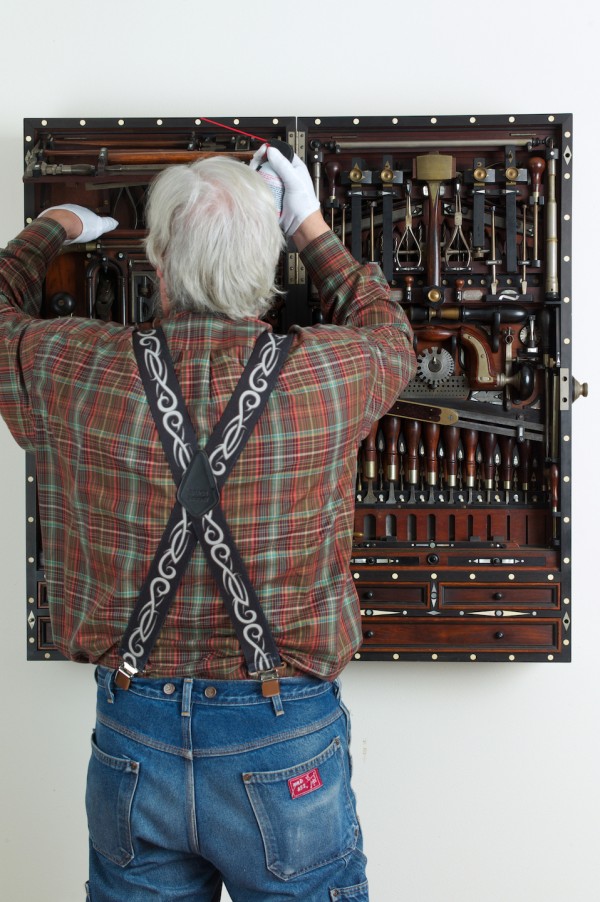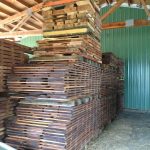We may receive a commission when you use our affiliate links. However, this does not impact our recommendations.
I wouldn’t typically give away free on our site an article that hasn’t yet been seen by magazine subscribers. But this is not a typical situation, and time is of the essence. Don Williams, whose latest book, “Virtuoso: The Tool Cabinet and Workbench of Henry O. Studley” (with photographs by Narayan Nayar) will be shipping in just few weeks from Lost Art Press. But the book will be available for the foreseeable future.
What is far more pressing is that for the first time since it was on display in the late 1980s at the Smithsonian Institution, you have the opportunity to see this stunning tool cabinet, the tools therein and Studley’s workbench (never-before displayed) in person, for three days only: May 15-17 at the Scottish Rite Temple of Cedar Rapids, Iowa (in conjunction with Handworks in nearby Amana, Iowa). It is unlikely this chance will ever come again. Tickets are $25, and only 1,200 are being sold – and as I write this, there are still some available…which astounds me.
So, I share here with you the End Grain column Don wrote about Studley for the June issue, which mails later this week.
Get your tickets. Get to Iowa. I’ll see you there.
— Megan Fitzpatrick
p.s. To subscribe to Popular Woodworking Magazine, click here for digital and click here for print.
Decoding the Mystery of Piano and Organ Maker Henry O. Studley
by Don Williams
The amazing tool cabinet of piano-maker Henry O. Studley has fostered intense admiration and contemplation surrounding its origins and creator for nearly three decades. I’ve heard a lot of this speculation while conducting research for the book “Virtuoso: The Tool Cabinet and Workbench of Henry O. Studley” (Lost Art Press). About the only thing I’ve not heard is that Studley’s creative genius was proof of extraterrestrial visitation.
The reality is both inspiring and mundane.
Who? Studley was born in 1838 in Lowell, Mass., into a family of skilled tradesmen; he died in Quincy, Mass., in 1925. As a young man he mastered the cabinetmaking trade and worked nearly his entire adult life in the precision woodworking world of organ and piano building. The only known portrait of Studley presents him at the top of the piano-factory food chain.
What? His tool cabinet, filled with in many cases customized tools, and his workbench, were fabricated from premium mahogany. The cabinet is enhanced with ebony details and hundreds of ivory and mother-of-pearl inlays. The workbench top is laminated from mahogany faces on an oak core, and features two amazing vises.
When? Studley’s obituary states that the tool cabinet was constructed during his circa 1898-1919 tenure at the Poole Piano Company. I don’t (yet) know whether he built it in his free time or on company time, or how long it took.
Where? While there is no way to know where he built the cabinet and workbench, there is no record of a home shop; “the factory” is the likely answer.
How? This one is easy: with consummate skill. All the workmanship is crisp and confident, and the composition and detailing demonstrate genuine inspiration. Clearly the cabinet was constructed specifically for the tools it houses, with all the spatial and aesthetic details resolved prior to starting.
Why? I believe it is fair to conclude that Studley was simply showing off a lifetime’s acquisition of skill and tools. And given the skills evident in the cabinet’s design and execution, he had much to show off about.
In 2010, my inquiries about the tool cabinet led to a phone call from its owner, who invited me to visit and examine the cabinet and workbench. The rest, as they say, is history. The result is the book “Virtuoso” and the first-ever exhibit of the cabinet and workbench together, May 15-17, 2015, in Cedar Rapids, Iowa.
And yet, there is much left to learn about this enigmatic genius. PWM
Don is a furniture and decorative arts conservator and author of “Virtuoso: The Tool Cabinet and Workbench of Henry O. Studley (Lost Art Press). His web site is donsbarn.com.
Here are some supplies and tools we find essential in our everyday work around the shop. We may receive a commission from sales referred by our links; however, we have carefully selected these products for their usefulness and quality.










I cannot visit the Studley exhibit (pity, since I live in Cedar Rapids), but I would like to welcome everyone planning to attend Handworks 2015 in Amana, Iowa – Christopher Schwartz, Lost Art Press, George Walker, Eccentric Toolworks, and associates – and everyone reading this blog. Perhaps I’ll see your there.
Tracy J. Sanders
Cedar Rapids, Iowa
I do not think I will be able to make the trip to Iowa to Handwerks or to see Mr. Studley’s masterpiece. It is a tribute to his imagination and skill.
On a separate note, Megan, keeping the header in place that calls these “thoughts” will be a lie if you allow most of the drivel posted by Craig.olo to stand. His waxing poetic rings pretty hollow when you read his attack on Bill’s post.
I have been fascinated by this tool chest since I first saw the 1988 photograph. An amazing build by a master craftsman at the pinnacle of his career.
Is it art? Much of what we do as woodworkers invokes art at some level. I for one can only hope to approach the level of skillful execution in my own work that resulted in this amazing piece.
It’s obviously easy to look upon an exceptional object like The Studley Tool Cabinet and be stirred by it. The inspiration may take the form of motivation to see it and study it, to create something to match it, or even to be moved to question the rudimentary concepts of ownership out of jealousy caused by its existence and fill fully grown noble makers to petty namecalling. None of the places I keep my tools do that at all, much less, with such efficiency. The whole is more than the sum of its parts in that, a timeless object which stands alone… until you hear about the bench… powerful opportunity… thanks for sharing it, everyone involved
Wow I was just going to throw a lighthearted jab at Don about keeping it on the downlow about the alien thing, wink wink, nudge nudge.
Next to all the truds in the swimming pool I guess it won’t appear funny.
Bill I’m not sure who Craig DOT olo is, never seen him before, but at all levels I agree with what you have said, and if the aforementioned trud runs you off, IT wins. Treat it like the troll it is, and just ignore it.
What a truly amazing opportunity. I can’t imagine the foresight and work that Mus have gone into coordinating such an event. It’s one thing, and no small feat, to organize an inspection and evaluation of an object, another to record it, another again to organize this findings in a meaningful way, publish them, and on top of that, set up a viewing in person. It would take a confused woodworker not to appreciate the effort. Outstanding.
I feel the same way about your stuff… hand it over.
A person with really cool belongings wants to display them at a cost so low that they obviously aren’t making a profit. You want to confiscate them so everyone has a chance to see them.
You know what else? Someone should make a rule that keeps things from flying off the surface of the earth. Let’s call it gravity.
You would wet yourself if you knew how many public national treasures were buried under red tape, never to see the light of day again, or abused by caretakers who didn’t take any care.
There it is, enjoy the holy grail of tool alters for $25. Just go, or buy the book, and feel empty no more.
Do people even try to problem solve anymore, or is enough to point out that that opportunities don’t come with a concierge?
This is probably not my business, but on some level it bothers me that this tool cabinet is “owned”. Why? It is just my personal belief that certain items should belong to everybody. This is not meant as a knock to the owner of the cabinet, who I am sure paid good money for the honor. But this cabinet is a work of art, and in many ways a historical artifact, and I just so happen to believe it belongs in a museum and not in a private collection. Call me an idealist, or a Socialist, or Indiana Jones, but that is how I feel.